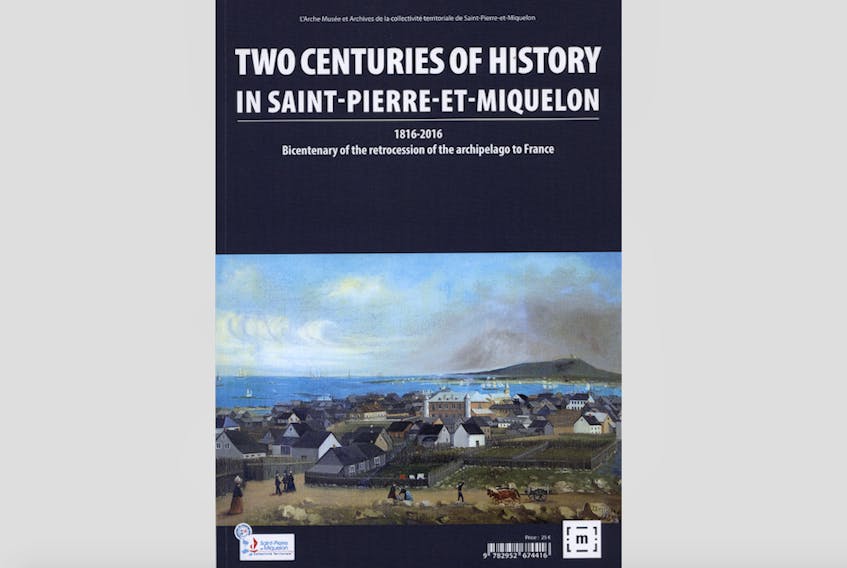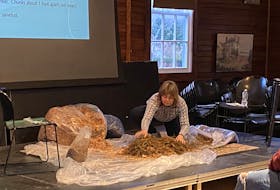GRAND BANK, N.L. – A few weeks ago I had the privilege of being on a panel discussing this area’s ongoing relationship with the French Islands of St. Pierre et Miquelon. The theme was entitled “The Ties That Bind” and it was meant to highlight the connections that exist between the two regions and our people.
The panel discussion, which also involved Lauriane Detchevery, assistant director of the L’Arche Museum et Archives of St. Pierre, was hosted by Dale Jarvis , a well-known folklorist with the Heritage Foundation of Newfoundland and Labrador.
The panel was part of a three-day “Tourism Opportunities Forum,” organized by the Legendary Coasts of Eastern Newfoundland, and attended by government personnel from St. Pierre et Miquelon and this province as well as people directly involved in tourism. It also included a bus tour to Lord’s Cove, St. Lawrence and Fortune with stops at The Pantry in Lord’s Cove, the St. Lawrence Miner’s Museum and the Fortune Head Geology Centre.
Attendees were also treated to a wool spinning demonstration by Melaine Lambe, an overview of Lord’s Cove by Margaret Mary Martin, a presentation and singing by Sean Sullivan and Sheldon Thornhill of Sullivan’s Songhouse and Culinary Tastings with food prepared by Chefs Chris Sheppard, Katie Hayes and Jean-Patrick Audouze. Musical entertainment during the event was also provided by Clayton Herridge and Chris Farrell.
Those of us who live in Fortune Bay and on the western side of the Burin Peninsula can trace our history, as we know it today, back to 1763 with the signing of the Treaty of Paris.
For seven years prior to 1763 France and England had been at war. When finally Britain won and succeeded in establishing control over North America, the Treaty was signed and a peace pact was negotiated.
In the final settlement France was permitted to continue fishing on what was known as the French Shore and also in the Gulf, and was granted the strategically located islands of St. Pierre et Miquelon as a fishing base.
During the 50 years prior to 1763, St. Pierre and Miquelon was owned and settled by the British. According to historian Garfield Fizzard, the British had established a sizeable settlement in St. Pierre. In 1759 the number of year-round residents was 408 plus another 300 ‘summer servants’.
St. Pierre was indeed a busy place. At the time the island was the centre of the English fishery in the region.
In June 1763 a French warship arrived in St. Pierre carrying a new French Governor, along with 150 settlers and 50 soldiers. It was time for our British forefathers to leave.
Another local historian, Aaron F. Buffett, in his writings in the 1940s, states “the British inhabitants were moved by the British soldiers to Newfoundland. The Hickmans were taken to Grand Bank, the Snooks to Fortune where a special area was allotted to them (the boundaries being trenched by the soldiers), the Grandys to Garnish and the Cluetts to Belleoram.
The Hickman, Snook, Grandy and Cluett names are still very prominent in these communities today.
I had always thought that the people of St. Pierre et Miquelon would, similar to us, trace their present history back to 1763. However, during our recent panel discussion, I was informed by my French counterpart, Lauriane Detcheverry, that is not the case. In actual fact, our French neighbours only celebrated their bicentenary a couple of years ago in 2016 (1816-2016).
In the words of Detcheverry, “from 1763 to 1816 Saint-Pierre et Miquelon went through many hardships and was the victim of the many conflicts between France and England.”
Apparently after our English forefathers left St. Pierre in 1763 — a lot of people from former French possessions settled in the archipelago, but there were too many of them: in 1768 more than 500 people had to be sent back to France because of a lack of food. Then 10 years later, in retaliation to France’s support for the American War for Independence, the British attacks Saint-Pierre, deports the 1,250 residents back to France and razes the town.
The ownership of the islands changed hands a couple of more times before the last treaty in late 1815 finally restored the islands to France. In the spring of 1816 some 645 survivors of the 1793 expulsion returned for the last time; Saint-Pierre-et-Miquelon to remain under France from then on.”
“They are the source of our actual population, along with all those who were attracted by the prosperity of our economy during the second half of the 19th century,” Detcheverry explained.
In a follow-up article we will delve further into the history of our French neighbours, talk about their love for music and dance, and explore the ties that over the decades have brought our two peoples closer together.
Allan Stoodley is a long-time resident of Grand Bank. He can be reached at [email protected] and he welcomes comments on this or any other article he has written.









